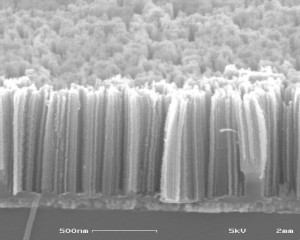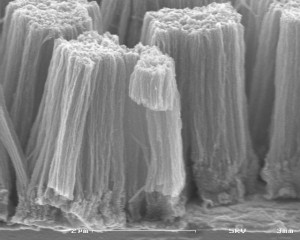Structured Silicon for Energy Storage in Microsystems
- Category: Energy
- Tags: carl thompson, kathleen fitzgerald
Micro-batteries provide a critical component for self-powered autonomous microsystems. Lithium-ion batteries provide relatively high energy storage capacities. Improvement in energy storage capacities over current generation lithium-ion batteries is achievable by using silicon as the anode material. Silicon offers the highest known lithium capacity at the cost of large volume changes, making monolithic silicon structures such as fully dense films or substrates unusable. For silicon-based lithium batteries, nanostructured silicon with high surface-to-volume ratios and superior mechanical properties over bulk are being investigated[1],[2].
We use metal-catalyzed etching (MCE) to fabricate porous silicon from fully dense silicon films, a process that offers low-cost, room temperature processing of silicon[3][4][5][6]. A thin discontinuous metal film is deposited on the silicon and catalyzes the dissolution of silicon when immersed in a solution containing hydrofluoric acid and an oxidant like H2O2. While the monolithic film undergoes significant pulverization and fails in the first few cycles, the porous silicon film shows stable cycling over 25 cycles at a capacity of 2250 mAhg-1 at high rates, expanding nearly three times its size but remaining adherent to the current collector (Figures 1 and 2). Work is currently underway to improve the cyclability of such films and integrate them into solid state batteries for on-chip energy storage.
- Figure 1: Porous amorphous silicon on glass using MCE. This structure is able to accommodate the volume expansion that occurs during lithiation.
- Figure 2: After lithiation, the porous amorphous silicon film breaks into large columnar islands that remain adherent to the current collector.
- S. M. Hemmingsen, Soft Science. Saskatoon: University of Saskatchewan Press, 1997. [↩]
- J. R. Beveridge and E. M. Riseman, “How easy is matching 2D line models using local search?” IEEE Transactions on Pattern Analysis and Machine Intelligence, vol. 19, pp. 564-579, June 1997. [↩]
- J. L. Dawson and T. H. Lee, “Automatic phase alignment for a fully integrated Cartesian feedback power amplifier system,” IEEE Journal of Solid-State Circuits, vol. 38, no. 12, pp. 2269-2279, Dec. 2003. [↩]
- S. J. Steinmuller, C. M. Gurtler, G. Wastlbauer, and J. A. Bland, “Separation of electron spin filtering and magnetic circular dichroism effects in photoexcitation studies of hybrid ferromagnet/GaAs Schottky barrier structures,” Physical Review B, vol. 72, pp. 045301:1-5, July 2005. [↩]
- N. Osifchin and G. Vau, “Power considerations for the modernization of telecommunications in Central and Eastern European and former Soviet Union (CEE/FSU) countries,” in Second International Telecommunications Energy Special Conference, 1997, pp. 9-16. [↩]
- S. Al Kuran, “The prospects for GaAs MESFET technology in dc-ac voltage conversion,” in Proc. Fourth Annual Portable Design Conference, 1997, pp. 137-142. [↩]

